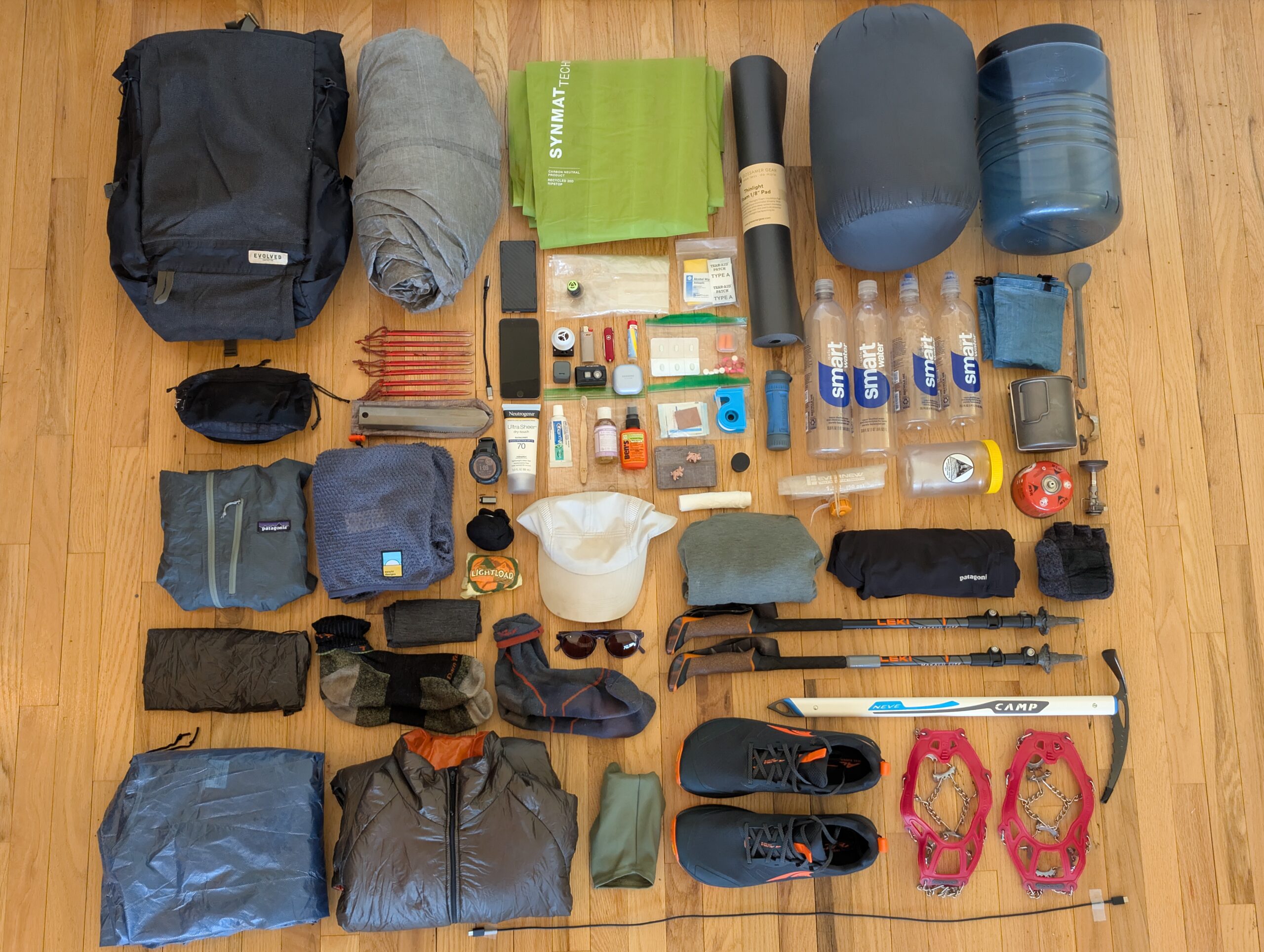What’s in my Bag?
Amy and I are gearing up for the west coast. What we will carry on the PCT is quite different than what we carried on the AT. The reasons why we made so many changes are varied; old gear needed replaced, new products were invented, or the terrain requires specialized equipment. I’ve always enjoyed consolidating my gear and counting grams, so I wanted to share an updated list of our load-outs for the PCT, as well as brief justifications and a comparison to the gear that we used for the AT.
The following gear list is primarily for me (Alex), but includes all gear that Amy and I will be sharing, some of which she will be carrying. Whereas on the AT our two-person tent was the only major piece of shared gear, we are experimenting with a true “couples” setup this time, in which our tent, sleeping pad, quilt, cooking system, and a few miscellaneous items will be shared between us. There are a few benefits to this beyond reducing the weight and volume of our gear, which I will cover in detail below.
For reference, we are planning to start our hike on April 20, 2025 on the Mexican border heading northbound. We hope to reach the Canadian border around five months later in September. Starting in late April means we might avoid excessive snow in the mountains, but it really just depends on the total amount of snowfall this year.
Backpack
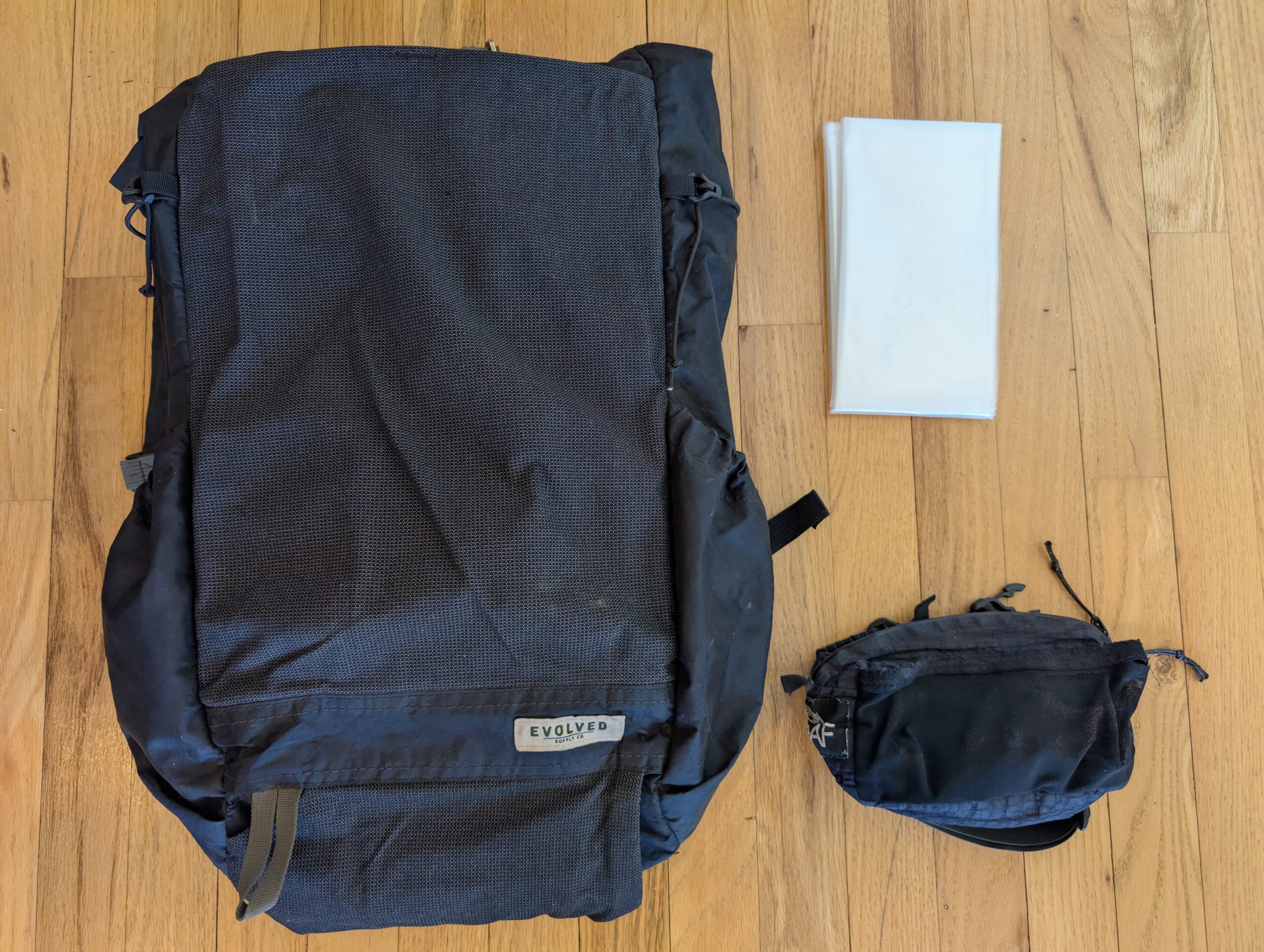
As far as a backpack goes, there is not much about the PCT that requires drastically different needs than that of the AT. I will need the capacity to haul greater loads of water through the desert, a way to carry a bear can for sections of the trail that require it, and possibly a convenient way to carry an ice axe.
The DCF backpack that my friend Tim made for me has sadly reached the end of its life after experiencing unspeakable abuse by the Appalachian Mountains. I switched to The Ranger made by Evolved Supply Co. This pack is made from primarily Ecopak EPLX 200 (a more eco-friendly variant of Xpac). After several expeditions, I have been quite happy with it. My favorite features are the compact design, the deep side pockets, the “snack” pocket on the bottom, ice axe carrying loop, and the Y-strap for attaching a bear can to the top of the pack. The biggest drawbacks are that I had to order separate water bottle holders to attach to the straps and that there is not an easy way to insert a sit pad on the back that doubles as a back pad while hiking.
It is a no-frills pack with a single interior compartment where I will stuff pretty much all of my gear. Concerning volume, this pack is certainly on the smaller side at 35L of carrying capacity. This may be a bit of a squeeze when I need a lot of water, but should be fine otherwise. There is also a removable hip belt, which I do not currently plan to use for the hike.
I am using a LiteAF Fanny Pack to store essentials that I need to access quickly on trail. It will contain my phone, headlamp, earbuds, wallet, knife, and a bottle of soap. I will continue to line the inside of my backpack with a plastic Pack Liner by Gossamer Gear. This guarantees everything inside will stay dry, even in a rainstorm.
Sleep System
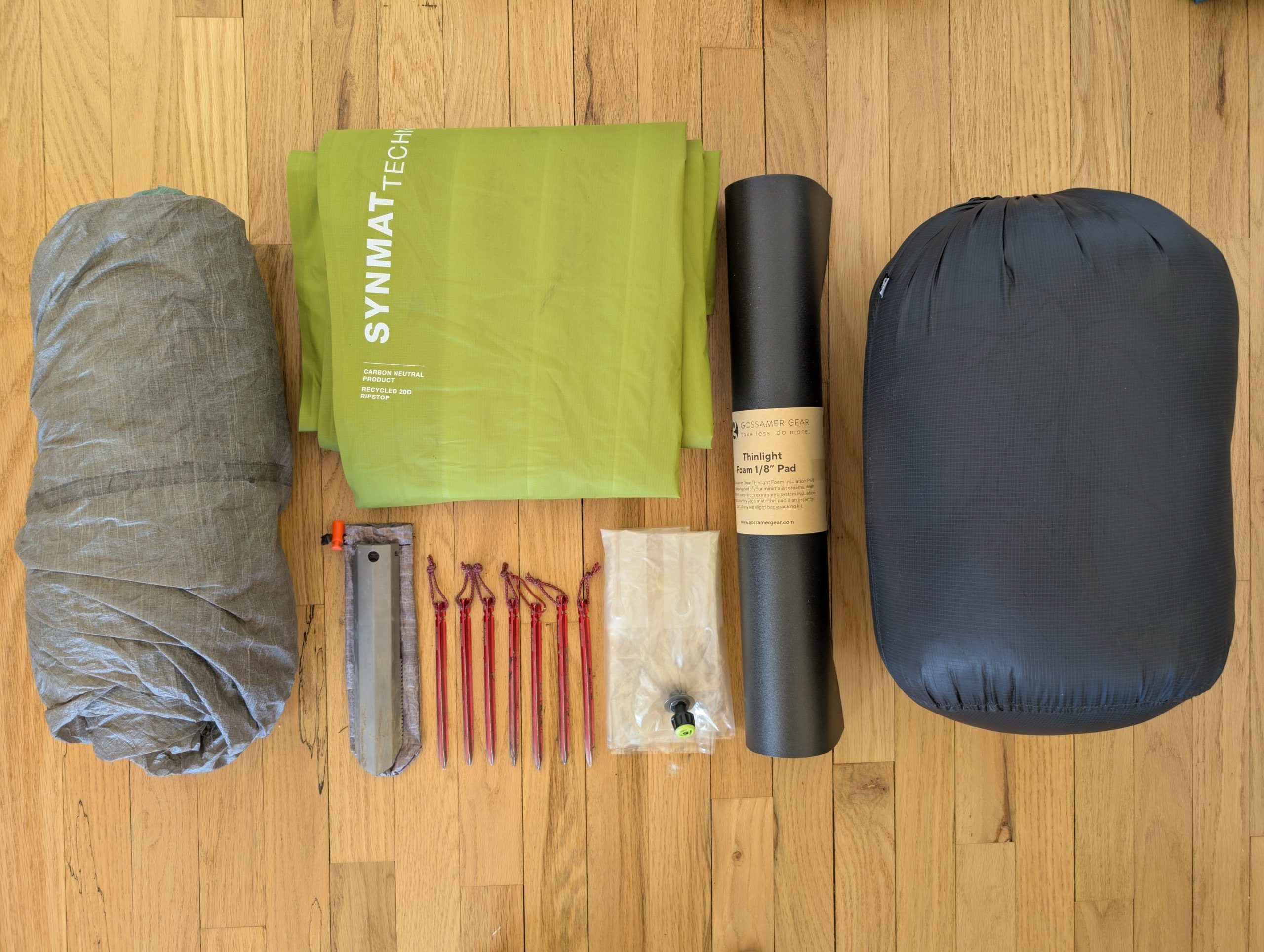
I will be using the same tent that I used on the AT. The Zpacks Duplex is a powerhouse of efficiency and has held up exceptionally well. There are a few tiny holes in the mesh I need to patch, but the DCF is still going strong. There are now a couple of more spacious options on the market, but I really don’t mind the squeeze. On the AT, the single wall exterior was regularly overwhelmed with condensation when it rained, to the point where I would wake up in pools of water. So why am I staying with it for the PCT? Because the west coast is dry, dry, dry and I rarely expect condensation to be an issue.
Perhaps the biggest drawback is that it is a trekking pole tent, which will make it very hard to pitch if I ever find myself camping on top of snow or rocks. I am still using MSR Groundhog Mini stakes to pitch the corners and the guylines, since they are virtually indestructible. A small change is that I am replacing one of the eight stakes with a Vargo Dig Dig, titanium trowel/stake combo. I will use this for one of the less important guylines, since it is not quite as effective as a regular stake, but provides the additional functionality as a trowel to dig catholes. I’ve also sewn a simple DCF bag to hold the trowel and stakes to prevent them from ripping my pack.
I upgraded our sleeping pad to an Exped Synmat Duo. This is an inflatable, 40″ pad with space for both me and my wife to share. Despite what you might think, this pad is marginally heavier when compared to the two single pads we carried on the AT (824g > 411g + 368g = 779g). A double wide pad only eliminates a single “wall” of material via a split baffle that runs down the middle of the pad. This means we can inflate each side separately to our desired firmness and the affects of rolling around are hardly noticeable to the other person. The reason it is heavier is simply because this pad is longer than the cut down pad I was previously using.
Overall, we are getting a more comfortable and longer pad that feels wider since it does not have an annoying gap between us, all for only a slight increase in weight. After using this pad on a few hikes already, I will say it is one of the biggest backcountry sleeping upgrades ever and would strongly recommend it to any couple sharing gear on the trail. The only question mark is how this pad will hold up from a durability standpoint. I will, of course, be carrying a patch kit to address any leaks.
Much like the sleeping pad, we also upgraded our quilt to the double wide, Enlightened Equipment Accomplice (20 degree temperature rating, 950fp, regular length). Now, our combined stink will be trapped under the same blanket at night. Unlike the duo sleeping pad, this quilt is lighter than two individual quilts. However, that is again not why we made the switch. My old quilt had many nights under it and had lost quite a bit of down insulation, so it needed replaced regardless. In addition to being fully stuffed, 950fp is a high quality goose down that should be a bit loftier and warmer than the 850fp down of our old quilts. A major benefit of a duo quilt is that our body heat will be shared, a significant factor that I expect to add 5-10 degrees of warmth to the temperature rating.
In addition to the inflatable sleeping pad, I am carrying a Gossamer Gear Thinlite 1/8″ Foam Pad that will be rolled up on the outside of my back. This is an incredibly versatile piece of gear that functions as an easy-access pad for sitting, a full-length pad for laying down during a siesta, as well as an actual sleeping pad for additional insulation under my inflatable sleeping pad at night. R-value (basically a measure of warmth/insulation) is additive, so layering two sleeping pads on top of each other makes the whole setup warmer. It also protects the inflatable pad from puncture wounds. If a puncture were to occur, at least I will have a thin foam pad to lay on, rather than nothing. One more sneaky benefit is that I can wrap the pad around my bear can while hiking. I’ve had issues with the bear can falling off the top of my pack, but the grippy foam should help secure it in place better.
Lastly, my pillow setup is unchanged: a Nemo Fillo Elite with no pillowcase, but instead wrapped around a lightweight Buff. If I have extra clothes available, they can be folded up and inserted underneath the pillow to add additional height. This setup is my pillow endgame. It weighs almost nothing, yet provides comfort for back sleeping and support for side sleeping.
Clothing

Clothing demands on the PCT might be the greatest difference when compared to the AT. The PCT is sunnier and will have less tree coverage, meaning I should be prepared for extremely high UV exposure. Clothing will always trump sunscreen in effectively protecting the skin. In addition to the sun, since the PCT will have mountains at much higher elevation, I need to be prepared for unexpected storms and potential snow. Rain, which was a regular part of life on the AT, should be uncommon on the PCT (save for Washington).
I am switching to a sun hoodie as my everyday base layer. Specifically, an Evolved Supply Co. Mirage that is made of a merino wool/polyester blend. I don’t anticipate this lasting the entire trail and will likely need to switch it out at some point. The long sleeves include a thumb loop help protect my hands from sunburn. The hood, of course, will protect my neck, scalp, ears, and part of my face. A standard cap will take care of the rest. I am bringing a Tilley Airflo Cooling Cap.
I am sticking with shorts, despite the sun concerns. It is just how I prefer to hike. I bought a pair of Patagonia Multi Trails with a 6″ inseam, which are very similar to the pair I wore on the AT. These include a liner and I will continue to avoid underwear like a true rebel.
On my feet, I will wear ankle length, Darn Tough socks. I was not impressed with toe socks on my previous hikes, and am firmly in the camp that Darn Tough, merino wool socks are the most durable and comfortable socks for hiking. If I happen to get a hole, I will exchange them for a free pair using the lifetime warranty. I am planning to carry two pairs of socks, so I can alternate between washing/drying one pair while wearing the other. Foot hygiene is essential while thru-hiking.
My shoes are Altra Lone Peak 9+. They are light on the feet, comfortable, and have decent traction. The greatest flaw I’ve noticed with Lone Peaks is that the tread is not particularly durable. The latest generation of these shoes optionally provides a Vibram outsole to replace the MaxTrak tread. Vibram outsoles are supposedly more durable and I plan to test this claim over the first 700 miles through the desert. This all being said, usually by time the tread is starting to reach its limit, the insole is a flat as a pancake and needs replaced anyway. After dealing with some minor plantar fasciitis on the AT, I am hoping to be more diligent in replacing my shoes every 500 miles or so. This means I will probably burn through at least five pairs of shoes over the course of the trail.
I made the the mistake of allowing my trekking pole tips to be ground to a nub on the AT. The poles were carbon and would otherwise have lasted a few thousand more miles if I could install fresh tips. However, since that doesn’t seem to be possible, I bought a new pair of trekking poles. This time, Leki Makalu Lite. These pole have been solid for the first couple of hikes I’ve taken them on. They serve a dual purpose in both preserving my old man knee caps and acting as supports for our tent. Since Amy carries a pair too, we utilize her poles to add additional height to the guylines of our tent, by first wrapping the line around the half way point of a trekking pole, then staking it straight down. This may seem minor, but adds additional space for our heads and feet in our small tent.
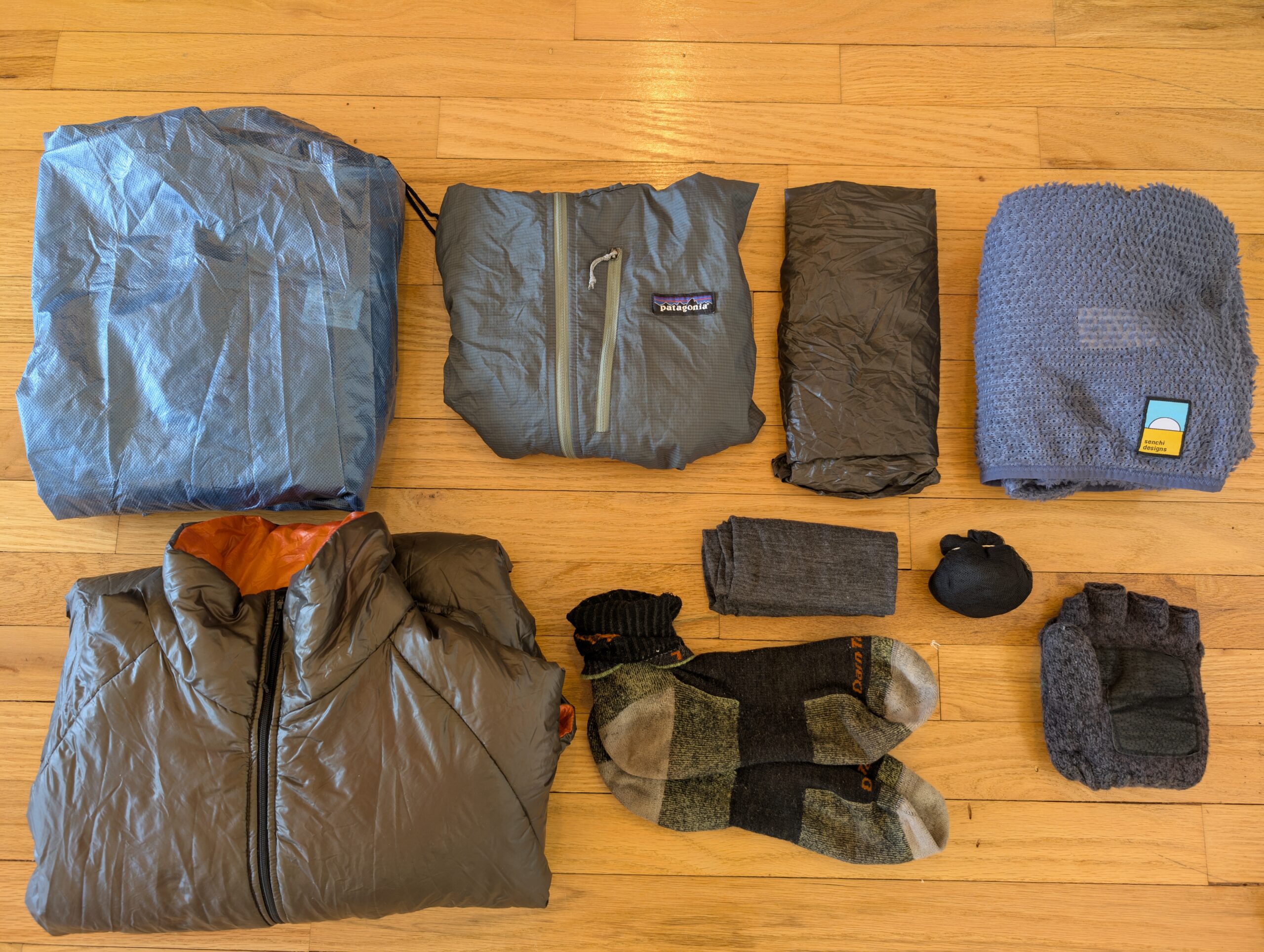
I am bringing a few more articles of packed clothing. First, a merino wool Buff that has about a dozen uses including a pillowcase, pot holder, face mask, and hat. I am carrying a cheap, Frog Toggs rain poncho for the odd day when it rains. For warmth, I am pairing a 60gsm Alpha Direct Senchi hoodie with a full outfit of wind protection, a Patagonia Houdini wind jacket and Enlightened Equipment Copperfield wind pants. I believe wind protection will be very important on the PCT, since I will be hiking on exposed ridges at high elevation.
The alpha fleece + wind shirt combo is extremely effective. Without delving too much into the science, the shortcoming of the fleece is that it the slightest breeze strips away any of the heat it captures. The wind shirt addresses this problem. When paired together, I’ve found this combination to be one of the most versatile, comfortable, and warm layering systems for its weight. Adding in my sun hoodie as a base layer, and this simple system will be comfortable into the low 40s. This is an active layering system that will be most effective while I am hiking, not sitting at camp.
If on trail I am expecting temperature to dip into the 30s or below, I may consider adding my synthetic puffy jacket, an Enlightened Equipment Torrid. This could be worn over my fleece and under my wind jacket, for a setup that would keep me warm in freezing temperatures even sitting still at camp. If I am facing significantly more rain and cold temperatures when I reach Washington, I will likely swap my poncho for an XL Frog Toggs rain jacket to address the shortcomings of the poncho in high wind situations and add a pair of MLD Event rain mitts to keep my hands warm.
I’m throwing in a thin pair of CHAMEECE fleece gloves by Montbell for chilly mornings in the desert. Also important for the desert is a pair of Dirty Girl gaiters, that will cover the top of my shoes to prevent them from being flooded with dirt. If sand or rocks find their way into your socks, it can cause blisters. A pair of gaiters is the best way to avoid this and will prevent us from having to stop walking and pour dirt out from our shoes.
Depending on the season, bugs can get bad in the Sierras and up north. To address this, I am carrying a Sea to Summit bug head net that will protect my face from mosquitos. All worn clothing will be treated with Permethrin before the hike begins. This clothing treatment kills bugs on contact and lasts for many washes before needing retreated. I will also have a small bottle of Ben’s 30% deet bug spray to apply to our skin.
Lastly, for certain regions I will need to be prepared for ice and snow on the trail. For traction on ice, I have a pair of Kahtoola MICROspikes. These are basically a less intense version of crampons, but are lightweight and provide enough traction to climb moderately steep, icy trail. I will also have a CAMP Neve ice axe with me, reserved for some of the most precarious alpine regions. This is used to self-arrest (stop yourself from sliding down a mountain) if I were to slip and fall. This is a potentially life-saving skill that Amy and I will need to practice before hitting the highest mountain passes.
Electronics
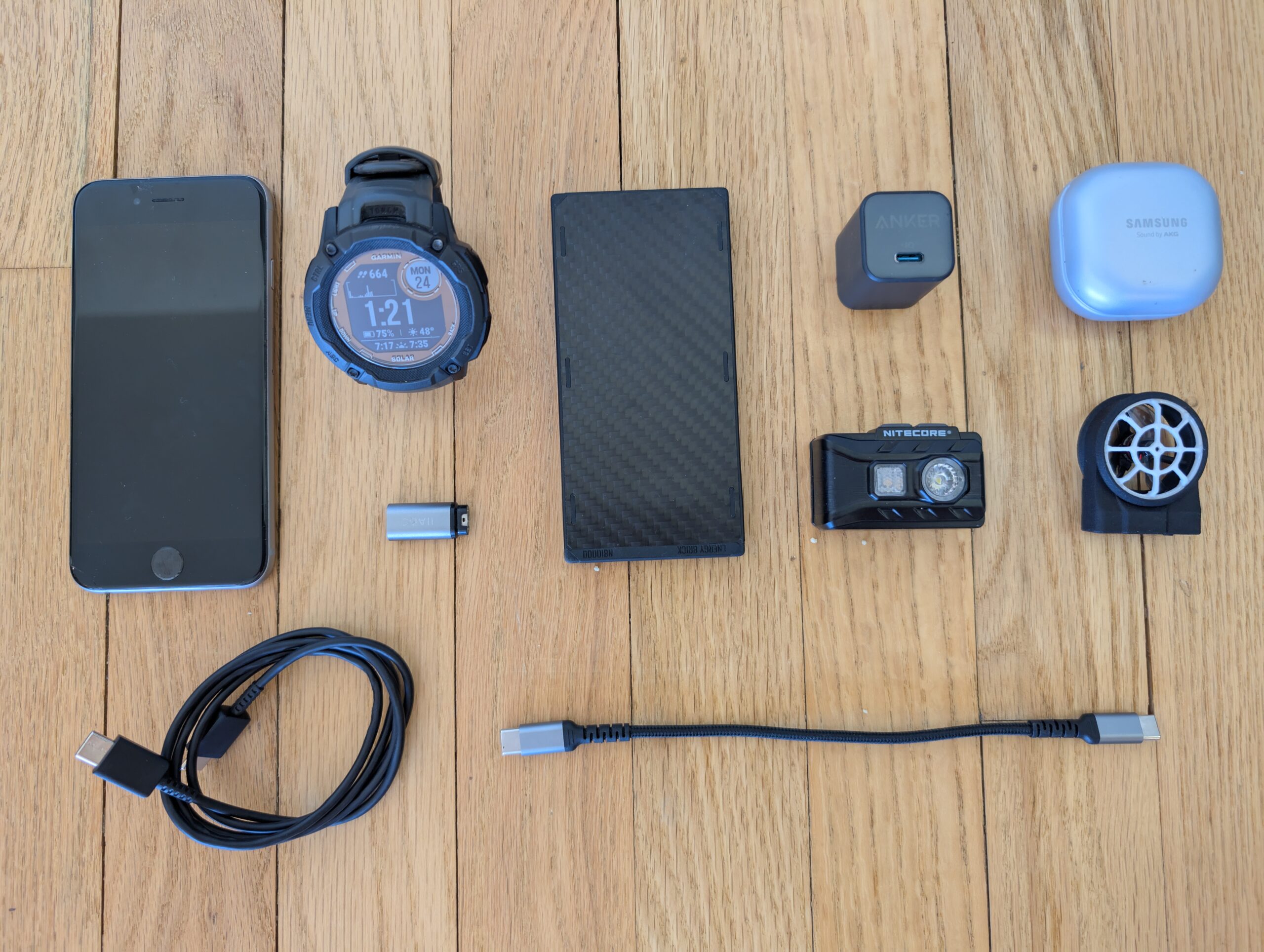
I can’t help falling victim to the lure of gadgets that improve life on the trail. A tech nerd at heart, I made a number of upgrades to my electronics system. In fact, I don’t think a single piece of equipment that I carried on the AT will be returning.
I consider bringing a camera with me on the AT to be one of the biggest mistakes I made. It was not at all worth the hassle despite snapping some decent shots. I’m ditching it, and relying solely on the camera of my Google Pixel 9 Pro. The camera on this phone is excellent and includes both a wide angle lens and a 5x optical zoom that should be useful for capturing wildlife. A phone is (ironically) one of the most important pieces of gear for the backcountry, since it covers communication, navigation, and photography. The Pixel 9 Pro even includes satellite messaging, which would allow me to activate SOS from almost anywhere in the U.S. if I were to get lost. For navigation, I will use the FarOut PCT guide. FarOut guides provide a ridiculous amount of helpful information and are well worth the price.
I picked up a Garmin Instinct 2X smartwatch that I expect to be a total game-changer compared to the basic Casio watch I previously used. The quality of life features are almost too numerous to list, but include a GPS, accurate mileage and elevation change tracking, bread-crumb navigation to return to a point if you get off trail, at-a-glance access to the weather, sunrise/sunset times, an altimeter, health tracking for how well acclimated I am to the elevation, and a built-in flashlight. In addition to all of this, multiple solar panels on the watch face will ensure that I won’t need to bother charging it often. This will also provide a ton of data for me to reflect on after the hike.
I am carrying a pair of Galaxy Buds Pro for music and audio book needs. Nothing too special about these, but I appreciate the microphone that allows outside noise to pass-through. This is nice for when I am talking while wearing the earbuds, and also for hearing the environment if something like a rattlesnake says “hello” while I’m hiking.
My headlamp is a Nitecore NU20 Classic. This version is very similar to my previous Nitecore headlamp, except that it has a USB-C charging port. Important features for me are that it’s lightweight, has a single lumen mode for very low light needs, a red light when I am trying to avoid bugs or preserve my night vision, and is bright enough at the max setting for night hiking during a new moon.
Perhaps the most unique and experimental piece of gear I’m bringing is a sleeping pad inflator that only weighs 9g, the PadPal v5.3. A clever hiker invented a simple, 3D printed inflator that doesn’t even have a battery. Instead, it plugs into a battery that I will be carrying anyway, and sips energy. According to the creator, a 10,000 mAh battery should provide enough power to inflate a sleeping pad 100+ times. I am very excited to see what it can do, especially since it weighs practically nothing. I’m expecting this little thing to save me from passing out lightheaded at least once.
To charge everything, I am using a Nitecore NB10000 Gen 3 battery. Perhaps the lightest battery on the market, it is also fully USB-C compatible and allows pass-through charging. This means I can plug it into the wall, then plug another device into the battery, and both the battery and the device will charge. This is extremely important for when I will not have much time in town, or when I need to charge two devices overnight. For a wall charger, I am using a Anker Nano 3, with a foldable prong and single USB-C port. This charges at 30W, so devices like my battery and phone will charge quickly. As far as cables go, I am planning to carry one 6″ USB-C to USB-C cord and one 3.3′ USB-C to USB-C cord. The longer cord will be useful if I need to use my phone while it is charging. Since all of my devices as now USB-C compatible, the only adapter I need to carry is one for my Garmin watch. You have no idea how important that is to me.
Diddy Bag

The diddy bag is where all of my small, yet essential pieces of gear fall into. For this, I like to use a gallon size Ziploc freezer bag. It’s waterproof and see-through and that’s all that matters to me. There is not much that is PCT-specific, but I have put a lot of thought into optimizing the little things over the years.
In addition to my electronics, the contents include: a kid-sized bamboo toothbrush, a travel tube of toothpaste, Dr. Bronner’s soap, foam ear plugs (so I don’t hear that bear squirrel snooping around my tent at night), a lighter, a towel, SPF lip balm, bug spray, sunscreen, sunglasses, Leukotape for blisters and wounds, toilet paper, a bidet attachment for my water bottle, a patch kit for my sleeping pad, DCF tape for tent repair, a sewing kit, a Swiss Army knife, some various pills, some cash and credit cards, our PCT thru-hiker permit, and most importantly, the two pigs from Pass the Pigs.
The Swiss Army Knife is a new addition. Whereas I previously just carried a pair of tweezers and sewing scissors, I wanted to have a small knife with me this time for one very important task: cutting cheese. Hard cheese and meats are great backpacking foods and I use the knife primarily for cutting food, but also for opening packages, etc. The Swiss Army knife includes scissors and tweezers as well, which are essential.
I used the battered DCF from my old backpack to sew together a simple, bi-fold wallet. It weighs only 7g and has space for 4 cards and some cash. The cards include my driver’s license for ID purposes, my health insurance card, a VISA credit card (important that it’s VISA so it is accepted everywhere), and my debit card. An embarrassing story is that neither Amy and or I had a valid debit card when we hiked the AT. When we needed to take out cash in Virginia, I found out that my card was expired. I had to take out a cash advance with my credit card which is something I would not recommend…
Food
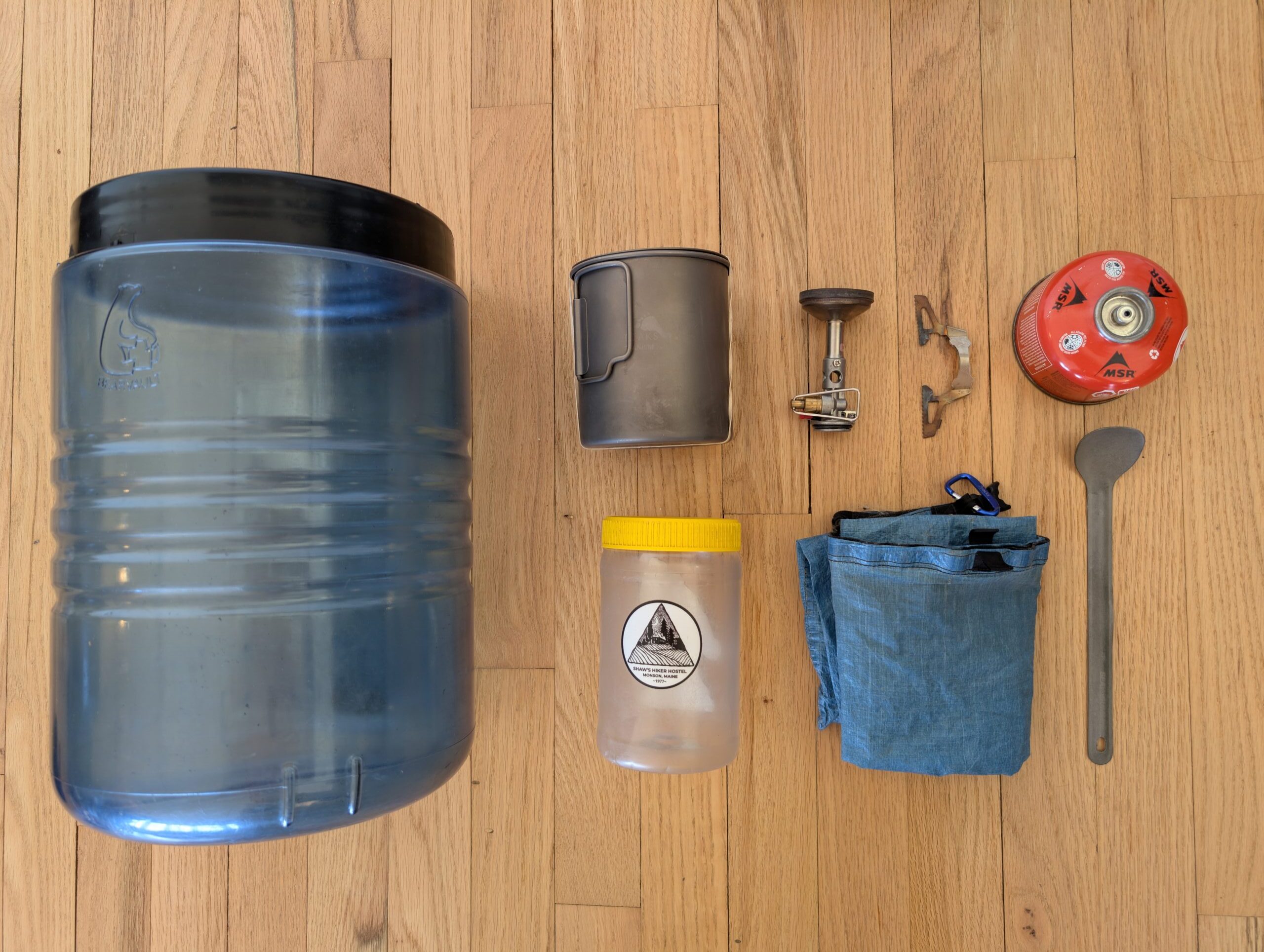
A hard-sided food storage container is required in some parts of the Sierras, northern California, and Washington, to prevent bears from getting into hikers’ food. For this, I am using a BV500, probably the most affordable and popular bear can on the market. At 2.5lbs, it will be the heaviest thing I carry in my pack. Fortunately, it will only be necessary to have one for less than a quarter of the hike. If we do not need a bear can, we will have our food bags instead. I’ll bring some paracord to do a bear hang, but I often just sleep with our food. In my opinion, this is better than doing a sloppy bear hang (which many are).
Amy and I will be trying out thru-hiking with a stove this time. We have a Soto WindMaster, which comes with a self-igniter and works well in windy situations. We use a three-prong pot support and a Toaks 700ml titanium pot for boiling water. Hiking with a stove on a thru-hike means dealing with refreshing fuel canisters as they run dry. I’ll most likely look for 4oz IsoPro fuel cans at resupplies, but may opt for a larger size since Amy and I will both be cooking. We are planning to do our cooking in the pot and sharing dinners on the trail for simplicity’s sake.
I also want to be able to cold soak meals when needed and will carry a stretchy, silicone lid to cover the pot and prevent leaks. Cold soaking will be a convenient option if we do ever run out of fuel, or if we are just not in the mood to cook. I like the idea of using a silicone lid and cold soaking in the pot instead of carrying a separate cold soaking jar or buying an expensive pot with a screw on lid. That being said, I may start the trail with both as Amy and I decide if cooking on a stove is something we want to do every night.
I am still using a long-handled Sea to Summit titanium spoon. Amy also picked up one of these, even though she made do with a plastic spoon from Dunkin Donuts for over half of the AT. The long handle is important for eating out of the pot.
I am sometimes asked by people not familiar with backpacking if I carry all of my food for the whole trip. For shorter hikes less than a week, I usually do. However, for a multi-month hike like the PCT, I will get off trail to resupply at a grocery store/gas station in town, ideally every four to five days.
Regarding our meals, we are putting a bit more effort into our resupply than we did for the AT. We plan to mail at least a few resupply boxes to various points on the trail. These will not be “self-sufficient” boxes, but will include dehydrated beans or other healthy dinners to supplement food that we can easily find in a grocery store. Our goal is to eat healthier this time around, but this is easier said than done when your only resupply option is a gas station with fifteen varieties of honey buns.
Water
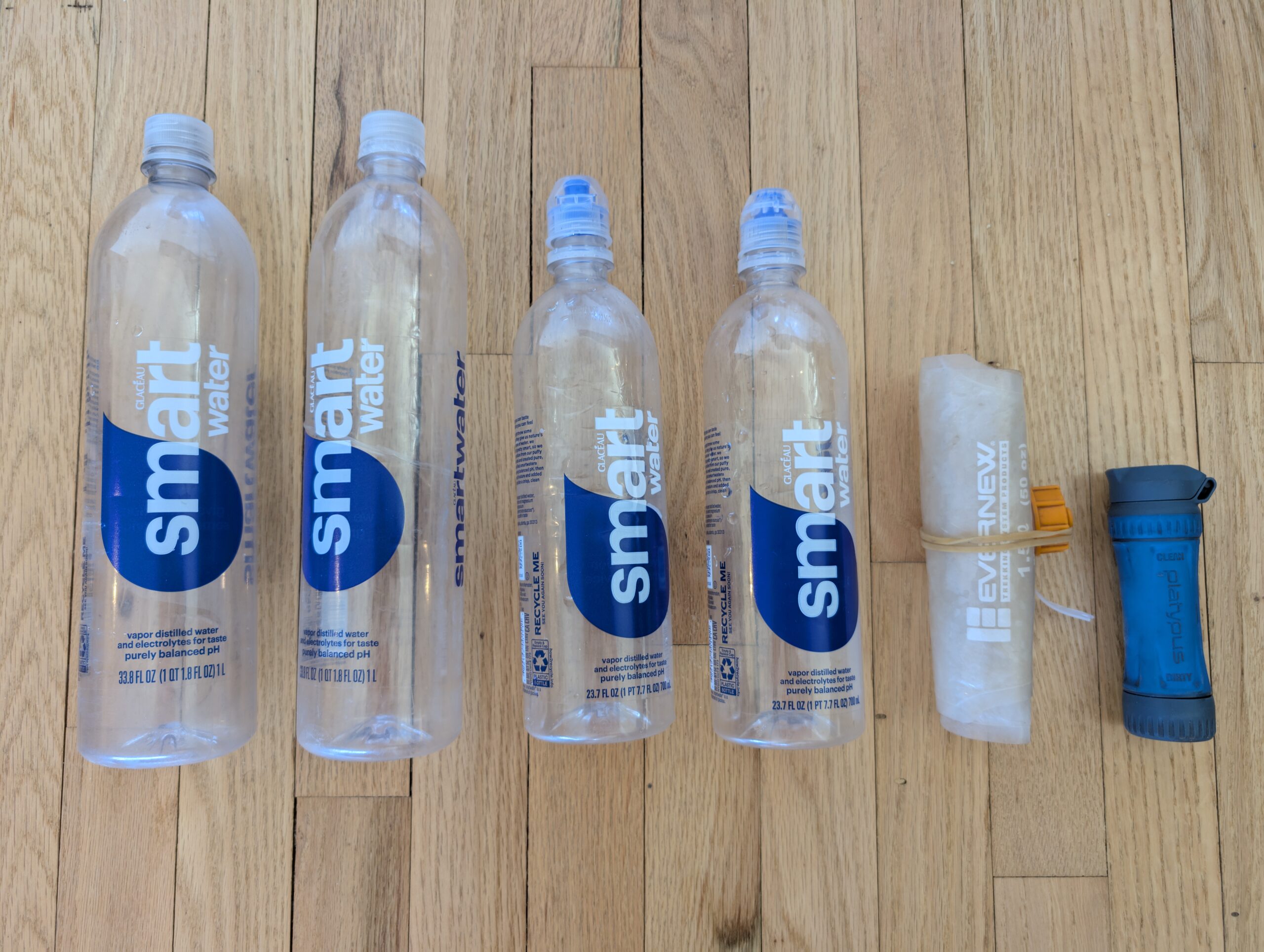
It is recommended to carry up to 6 liters of water through the desert section of the PCT. This is significantly greater than the 3 to 4 liters I carried on the AT, where streams are excessively common. My backpack is rigged up to carry two 700ml Smartwater bottles on the chest straps. In addition, I will start the trail with two 1L Smartwater bottles on the side pockets of my pack. Lastly, I will carry a 2L Evernew water bag strapped to the top of my bag or maybe inserted into my bear can. This is about 5.4L total and I will add or reduce capacity as needed.
The water bag and at least one of the 1L bottles will be for dirty water obtained directly from a stream or lake. The remaining bottles will only be filled with clean water filtered through our Platypus Quickdraw. I put this filter head to head against the Sawyer Squeeze on the AT, and ultimately prefer the Quickdraw because it has a slightly improved flow rate and is just nicer to actually use. This is an item where redundancy is critical so Amy will also carry one, as well.
I am sometimes asked by people not familiar with backpacking how I handle obtaining water. I use the aforementioned bottles and water filter to collect water from various sources we come across on trail, like springs, streams, and lakes, and run it through the water filter to remove bacteria that could carry disease. Ultrafiltration is actually overkill for ensuring safe, potable water.
Conclusion
Gear on thru-hikes is not at all static, and I’m sure some of what I’m bringing will be destroyed or lost within a month or two of hiking. I will keep track of changes to my pack in my regular journal entries, but this is at least what I am planning to start the hike with.
Stay Dirty,
Alex

